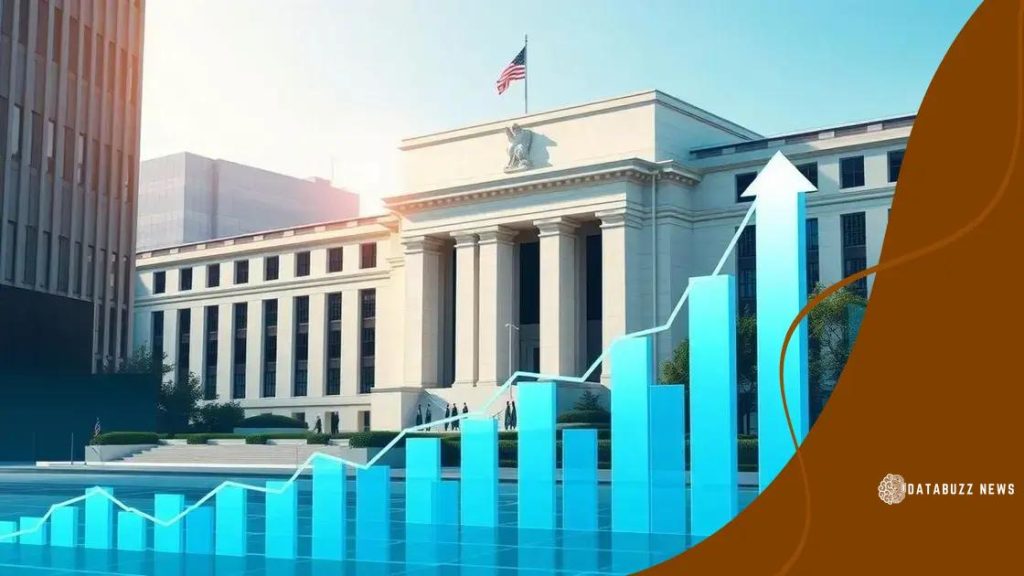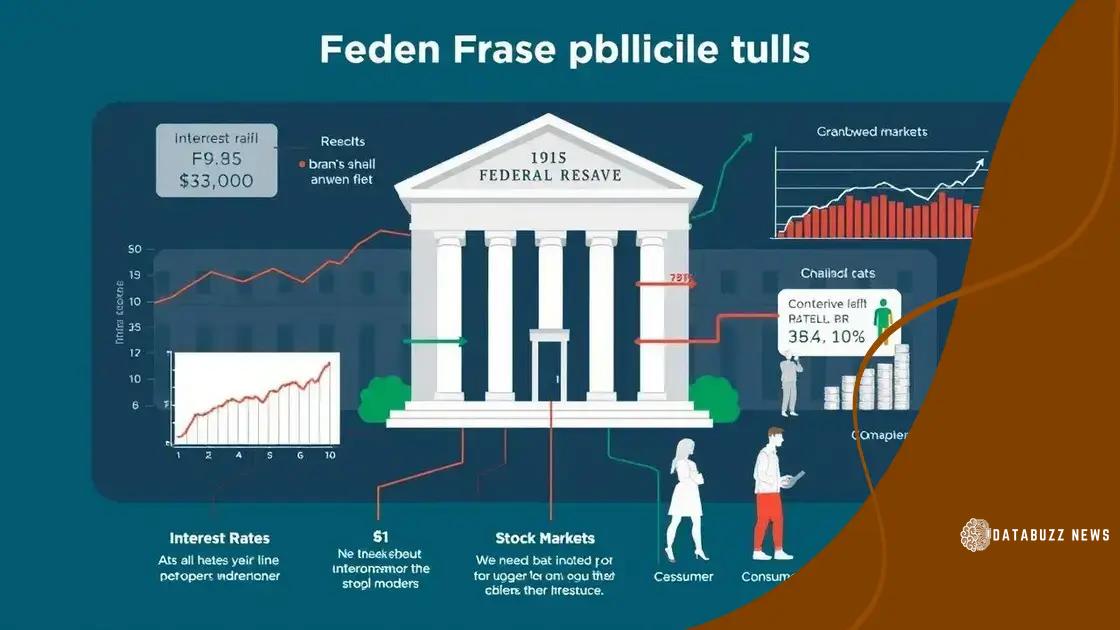Federal Reserve’s balance sheet normalization efforts explored

The Federal Reserve’s balance sheet normalization efforts involve reducing its asset holdings to manage inflation and stabilize the economy after periods of expansion, balancing market reactions and economic growth.
Federal Reserve’s balance sheet normalization efforts play a vital role in shaping today’s economic landscape. But have you ever wondered how these policies impact your financial stability? Let’s dive deeper into this topic.
Understanding the balance sheet of the Federal Reserve
Understanding the balance sheet of the Federal Reserve is crucial to grasping how monetary policy operates. The balance sheet reflects the assets and liabilities that the Fed holds, which influences interest rates, inflation, and overall economic performance.
At its core, the Federal Reserve’s balance sheet consists of a few key components. Let’s break it down:
Key Components
- Assets: These include government securities and loans to financial institutions.
- Liabilities: This mainly consists of currency in circulation and reserves that banks hold at the Fed.
- Equity: This represents the difference between the total assets and liabilities.
The balance sheet has expanded significantly, particularly after the 2008 financial crisis. It serves both as a tool for stabilizing the economy and as a signal of the Fed’s strategies. Understanding the implications of this expansion is essential for anyone interested in economics.
When the Fed buys bonds, it adds to its assets while increasing the reserves of banks. This can lead to more lending and, consequently, economic growth. Conversely, selling bonds decreases the balance sheet and can tighten monetary policy.
The Role of the Balance Sheet
The balance sheet acts as a critical instrument in influencing economic conditions. By adjusting the size of its balance sheet, the Fed can either stimulate the economy or cool it down. This action impacts interest rates, which in turn affects consumer borrowing and spending.
Overall, the Federal Reserve’s balance sheet is not just a financial statement; it is a reflection of the central bank’s policy decisions and a guide for investors and policymakers. Staying informed about these changes helps individuals and businesses understand potential market movements.
Historical context of balance sheet normalization
The historical context of balance sheet normalization offers insights into how the Federal Reserve has managed its monetary policy over time. Understanding this context aids in comprehending the current strategies employed today.
After the 2008 financial crisis, the Fed made significant changes to its approach. It expanded its balance sheet dramatically in an effort to stabilize the financial system. This expansion aimed to inject liquidity into the economy, mitigating potential declines in activity.
Key Events in Balance Sheet History
- 2008 Financial Crisis: The Fed’s balance sheet expanded from around $800 billion to over $4 trillion.
- Quantitative Easing: This tool was used to purchase long-term securities to promote lending and investment.
- Normalization Discussions: As the economy improved, discussions about reducing the balance sheet began.
As the Fed started normalization efforts in 2017, it aimed to gradually reduce the balance sheet size. This was a critical step toward returning to more traditional monetary policy after years of unconventional measures.
However, the process was met with caution. The Fed needed to balance the risk of increasing interest rates with the ongoing economic recovery. The historical lessons learned during previous normalization attempts informed the current approach.
Impact of Historical Decisions
Choosing when and how to normalize the balance sheet impacts financial markets and economic growth. As the Fed increased interest rates, it aimed to prevent overheating in the economy. Understanding past mistakes and successes has been key in shaping present actions.
In essence, the journey of the balance sheet normalization process has been complex and intricate. Historical context not only helps clarify the actions taken by the Federal Reserve but also assists in predicting potential future moves.
Key impacts on the economy and markets

The key impacts on the economy and markets from the Federal Reserve’s balance sheet normalization are significant. As the Fed adjusts its policies, these changes ripple through financial systems, affecting everything from interest rates to consumer spending.
When the Fed reduces the size of its balance sheet, it generally signals a tightening of monetary policy. This can lead to higher interest rates, which directly affect loans and mortgages. Higher rates can slow down borrowing, causing consumers and businesses to hold off on investing in expansions or purchases.
Influence on Interest Rates
- Mortgage Rates: As the Fed raises rates, mortgage costs increase, impacting home affordability.
- Loan Availability: Higher rates can lead to stricter lending standards.
- Consumer Spending: With higher borrowing costs, consumers may cut back on spending.
Additionally, stock markets often react to changes in Fed policy. When normalization signals confidence in economic strength, markets may initially rise. However, the prospect of rising interest rates can lead to volatility, as investors adjust their strategies.
Investment and Growth
The Federal Reserve’s actions also have implications for business investments. Companies rely on capital for growth. If borrowing costs increase due to higher interest rates, some firms may delay expansion plans. This can slow economic growth in the long term.
Conversely, if the normalization process occurs gradually and predictably, it can help maintain market stability. Investors appreciate clarity, and a well-communicated Fed can foster an environment of confidence.
In summary, the key impacts of the Federal Reserve’s balance sheet normalization are felt across various sectors of the economy. Recognizing these effects helps both consumers and investors navigate the economic landscape during periods of change.
Challenges faced during normalization
The challenges faced during normalization of the Federal Reserve’s balance sheet are complex and multifaceted. As the Fed moves to shrink its balance sheet, various economic factors present obstacles that need to be considered.
One primary challenge is managing market expectations. If the Fed announces plans to normalize too quickly, it might lead to panic in the financial markets. Investors are often sensitive to changes in monetary policy, and their reactions can cause significant volatility.
Key Challenges
- Market Volatility: Rapid changes can lead to unpredictable reactions in stock and bond markets.
- Interest Rate Sensitivity: Higher rates can dampen consumer spending and business investments.
- Global Economic Factors: Events in other countries can influence the impact of U.S. monetary policy.
Another challenge is balancing inflation and employment rates. While the goal is to reduce the balance sheet in a way that does not stifle economic recovery, the Fed must also be cautious of inflation rising too quickly. This balancing act is critical, as over-tightening can lead to recession.
Additionally, communication plays a vital role. The Federal Reserve must clearly convey its plans to avoid confusion. Clear communication helps set market expectations, making transitions smoother and reducing the likelihood of adverse reactions.
Long-term Implications
As the normalization process unfolds, the Fed must consider long-term implications for the economy. Each step taken has the potential to affect employment rates, consumer confidence, and overall economic growth.
In summary, the challenges faced during the normalization of the balance sheet require careful navigation. The Federal Reserve must weigh various factors and ensure that its actions promote stability while fostering economic growth.
Future outlook for Federal Reserve policies
The future outlook for Federal Reserve policies is shaped by several economic indicators and global trends. As the Fed continues its journey of normalization, understanding what lies ahead is crucial for everyone from investors to everyday consumers.
One significant factor influencing future policies is the ongoing state of the economy. Current economic growth rates, alongside inflation levels, will dictate how aggressively the Fed approaches interest rate changes. If inflation remains persistent, the Fed may have to raise rates faster than anticipated.
Key Economic Indicators
- Inflation Rates: Consistently high inflation could lead the Fed to increase interest rates more quickly.
- Employment Levels: A strong job market may lead to tighter monetary policy to prevent overheating.
- Global Economic Trends: Economic health in other countries can impact US policy decisions.
Moreover, the Federal Reserve always considers market reactions when making policy decisions. If markets perceive a policy shift as negative, it can lead to increased volatility. Thus, the Fed must communicate its intentions clearly to maintain market stability and confidence.
In addition, technological advancements and changes in consumer behavior can impact the Fed’s approach. For instance, the rise of digital currencies and payment platforms may lead the Federal Reserve to explore new monetary tools in the future.
Potential Scenarios
Several potential scenarios could unfold in the coming years. If inflation continues to rise, more aggressive rate hikes might be the response. Conversely, if economic growth slows, the Fed may need to adopt a more accommodative stance to support recovery.
In essence, the future outlook for Federal Reserve policies remains uncertain but closely linked to various economic signals. By analyzing these factors, stakeholders can better prepare for what lies ahead in the financial landscape.
FAQ – Frequently Asked Questions about the Federal Reserve’s Balance Sheet Normalization
What is balance sheet normalization?
Balance sheet normalization is the process by which the Federal Reserve reduces the size of its balance sheet after periods of expansion, often following economic crises.
Why does the Federal Reserve normalize its balance sheet?
The Fed normalizes its balance sheet to return to a more traditional monetary policy, manage inflation, and ensure economic stability.
What are the challenges associated with normalization?
Challenges include managing market expectations, dealing with potential volatility, and balancing growth with inflation control.
How can changes in the Federal Reserve’s policies affect me?
Changes can impact interest rates on loans and mortgages, affect employment rates, and influence overall economic growth.
